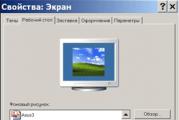Increase the power of the amplifier on the TDA7294 chip. TDA7294: amplifier scheme
Introduction
The amplifier for the subwoofer did not because of the lack or saving money, but for the sake of interest. In parallel, I did the same my son (already made 2 pieces).
I am not Meloman and not Audiophile, but I love music, often listen. The hearing is not deprived of hearing, at the same time, I do not understand people who begin to read the hundredths of nonlinear distortion, talking about the direction of wires and hearing the upper frequencies almost an ultrasonic band. All this is garbage and called the word - "disease". Not all people are endowed with perfect hearing, therefore everyone has their own ceiling. The main thing in the music that she would give pleasure. If you like the sound of your radio, acoustics, amplifier, then here you are happiness. Now it remains only to make an amplifier and power supply to it (voltage converter).
Amplifier for subwoofer on TDA7294 (bridge circuit)
 Why tda7294? Very cheap for beginners good parameters. The amplifier is very easy to manufacture. Printed circuit boards are full on the Internet. I did my seal under my body. Notcalculate in search of an ideal board. Take the one that suits you in design and sizes. There will be almost any fees in which errors are not allowed. It is desirable that the Earth would converge at one point, but if it is not so, it is not a fact that the scheme will not work or excite. On my board 1 and 4, the conclusions of the chip are not suitable for Earth separately, but are connected in series. Everything works without problems. If you first collect such schemes, then it is best to assemble a typical inclusion scheme. All schemes such as cheese and other homemade can not go, as they were driven by the authors for themselves and under their details. Typical scheme The inclusion is not critical to the details applied and with the right installation begins to work immediately. Power capacitors are not necessarily high capacity. 2200 μF for ears. The larger minus scheme is heat dissipation, so the radiator is more. I applied what was at hand (it turned out to be a little), heats up very much, I had to put three fans 50x50 mm (now the radiator is slightly warm). If it is possible, it is better to put a large radiator without hoping for the fans, as the fans may refuse. They in computers will not work for a short time, and in the trunk and will eat ahead of time. One more capital truth - chips on the radiator only through insulating gaskets and preferably the thermal paste.
Why tda7294? Very cheap for beginners good parameters. The amplifier is very easy to manufacture. Printed circuit boards are full on the Internet. I did my seal under my body. Notcalculate in search of an ideal board. Take the one that suits you in design and sizes. There will be almost any fees in which errors are not allowed. It is desirable that the Earth would converge at one point, but if it is not so, it is not a fact that the scheme will not work or excite. On my board 1 and 4, the conclusions of the chip are not suitable for Earth separately, but are connected in series. Everything works without problems. If you first collect such schemes, then it is best to assemble a typical inclusion scheme. All schemes such as cheese and other homemade can not go, as they were driven by the authors for themselves and under their details. Typical scheme The inclusion is not critical to the details applied and with the right installation begins to work immediately. Power capacitors are not necessarily high capacity. 2200 μF for ears. The larger minus scheme is heat dissipation, so the radiator is more. I applied what was at hand (it turned out to be a little), heats up very much, I had to put three fans 50x50 mm (now the radiator is slightly warm). If it is possible, it is better to put a large radiator without hoping for the fans, as the fans may refuse. They in computers will not work for a short time, and in the trunk and will eat ahead of time. One more capital truth - chips on the radiator only through insulating gaskets and preferably the thermal paste.
My printed circuit board is 100%. It was done with irony. If anyone will repeat it, then read the power tracks and output to the speaker.

 A couple of words about the crossover. Scheme from Shikhatov. The explanation scheme does not require. I did not go to the chip 544UD2 and its foreign analogue (changed several chips). It was excited at a frequency of about 1 MHz. I changed it on UD6 and everything became normal. Changes use good otherwise not to avoid cod in dynamics.
A couple of words about the crossover. Scheme from Shikhatov. The explanation scheme does not require. I did not go to the chip 544UD2 and its foreign analogue (changed several chips). It was excited at a frequency of about 1 MHz. I changed it on UD6 and everything became normal. Changes use good otherwise not to avoid cod in dynamics.


The construction of the housing for everyone has its own, I did in the old proven technology from a foolish textolite. It costs it is inexpensive, well processed, the housing is hard and beautiful. Painted with anti-agrees. Connector for food and speaker homemade, used part of a powerful relay. The amplifier is a complete design. With 35 volts, an 180 W of a undistorted signal (by oscilloscope) produces.



PS: For me, the amplifier cost cheaply, but if you do not have the stock of the parts and you will have to buy everything, it will present a certain amount of money. First, consider the costs, and then you will be able to work. In any case, this amplifier is ideal for the entry level.

We present to your attention stereo unch with a capacity of 100W Class H, which is easy to collect even novice radio amateurs. TDA7294 Integrated microcircuit in the Multiwatt15 monolithic case. It has a wide range of power supply voltages +/- 40V and can provide high output power on loads 4 and 8 ohms.
There are built-in short-circuit protection in the load and overheating protection (by reaching 145 degrees).
There is also a Mute function that is used to eliminate clicks when you turn on and standby (Stand-BY). Range of reproducible frequencies 20-20000Hz. Common harmonic distortion of no more than 0.1%.
Please note that the chip body is connected to -VCC, so it should not be installed in the metal case without isolation. Otherwise, will happen short circuit With land. Before screwing the microcircuit to the radiator, do not forget to apply the thermal paste.
Below is shown schematic scheme Power amplifier on the TDA7294 microcircuit.

The photo shows only one of the channels of the amplifier.

The figures show the circuit board and the location of the details on it.


The photos show the sequence of assembling boards
Notes:
The TDA7294 IC microcircuit is not compatible with resistors with a 1% tolerance.
About 1000MCF filter capacitors: If you use speakers with a diameter of more than 10 inches (25.4cm), you should increase the capacitors of the capacitors to 2200 mg.
Selecting a capacitor 47MCF: I recommend using 47UF 50V production of ELNA Silmicii and 47UF 50V production of Nichicon Muse KZ.
The TDA7294 microcircuit representing the low frequency integral amplifier, which is very popular among electronics, both beginners and professionals. The network is full of different reviews about this microcircuit. I decided and I assemble the amplifier on it. I took the scheme from the datashet.
This "Microcha" two-polar nutritionals feeds. For beginners, I will explain that it is not enough to have a "plus" and "minus".
We need a source with a plus output, minus conclusion and common. For example, a relatively common wire should be plus 30 volts, and in the other shoulder minus 30 volts.
The amplifier on the TDA7294 is quite powerful. The maximum passport power is 100 W, but it is with nonlinear distortions of 10% and at maximum voltage (depending on the load resistance). You can reliably shoot 70W. Thus, on my birthday, I listened to two parallel columns "S30 radio engineering" on one channel TDA 7294. Whole evening and half of the night, the speakers sounded, sometimes introducing them into overload. But the amplifier calmly stood up, although it was sometimes overheated (due to poor cooling).
Main characteristicsTDA7294
The supplied voltage + -10V ... + -40V
Peak output current up to 10a
Operating temperature Crystal up to 150 degrees Celsius
Output power at d \u003d 0.5%:
At + -35V and R \u003d 89W
At + -31v and R \u003d 6Ω 70W
At + -27v and r \u003d 4Ω 70W
At d \u003d 10% and increased voltage (See) you can achieve 100W, but it will be dirty 100W.
Amplifier scheme for TDA7294
The diagram is taken from the passport, all the nominations are saved. With the right installation and correctly selected items, the amplifier starts the first time and does not require any settings.
Empire elements
Ratings of all elements are indicated in the diagram. Power of resistors 0.25 W.
Mikruhu itself should be installed on the radiator. If the radiator comes into contact with other metal elements of the housing, or the radiator is the case itself, it is necessary to install a dielectric gasket between the radiator and the TDA7294 case.
The gasket can be silicone or saliva.
The area of \u200b\u200bthe radiator should be at least 500 sq. Cm, the more, the better.
Initially, I collected two channels of the amplifier, as the power source allowed, but I did not correctly picked the case and both channels simply did not fit into the housing in size. I tried to reduce the printed circuit board, but nothing came out.
After complete assembly of the amplifier, I realized that the housing is not enough to cool and one channel amplifier. The case was radiator. In short, she rolled his lip into two channels.
When listening to my device at full volume, the crystal began to overheat, but I had reducted the volume level and continued to test. As a result, I listened to the midnight to the music at a moderate volume, periodically driving the amplifier into overheating. The amplifier on TDA7294 was very reliable.
ModeStand- By TDA7294
If 9 legs to submit 3.5V or more, then the microcircuit comes out of sleep mode, if you submit less than 1.5V, it will be included in the sleep mode.
In order for the device to output from sleep mode, you need 9 legs via a resistor 22 kΩ to connect to the plus output (two-polar power source).
And if 9 leg through the same resistor to connect to the GND output (two-polar power source), the device will go into sleep mode.
A printed circuit board under the article is divorced so that 9 legs through a resistor 22 of the car is connected by a path with a plus output of the power supply. Consequently, when the power source is turned on, the amplifier immediately starts working not in sleep mode.
ModeMute. TDA7294
If the tda7294 is tda7294 to submit 3.5V and more, then the device will come out of the molding mode. If you submit less than 1.5V, the device will enter the migration mode.
Almost this is done like this: through a resistor 10 kΩ 10 foot chips connect to a plus of a two-polar power source. The amplifier "Soots", that is, will not be muffled. On the pCBwhich is attached to the article is done with the track. When power is applied to the amplifier, it immediately starts singing, without any jumpers and togglers.
If, through a resistor 10 kΩ 10 foot, TDA7294 to connect with the GND output of the power supply, then our "amp" will enter the muffling mode.
Power supply.
The voltage source for the device served as collected, which showed itself very well. When listening to one channel, the keys are warm. Also warm and Schottky diodes, although radiators are not installed on them. IIP without protection and softstart.
Many criticize the scheme of this IIP, but it is very easy to assemble. It works reliably without smooth inclusion. This scheme is very suitable for novice electronics due to its prostate.
Case.
The case was bought.

One of the first by me was collected by the amplifier on the TDA7294 according to the scheme proposed by the manufacturer.

At the same time, the quality of sound reproduction especially in the field of high frequencies is not very satisfied. On the Internet, my attention was attracted by the Lincor article, posted on DataGor.ru. Enthusiastic reviews of the author about the sound of the umzch at TDA7294, assembled according to the voltage source scheme controlled by voltage (Itun), I was intrigued. As a result, I was assembled by UMPs according to the following scheme.

The scheme works as follows. Input signal in inputs through the passage capacitor C1 to the low-intended shoulder feedback R1 R3, which, together with the C2 condenser, forms a FGH, which prevents the penetration of the filing and RF of noise into the sound path. Together with the R4 resistor, the input chain creates the first OOS segment, which is 2.34. Further, if not a current sensor R7, the gain of the second chain was set by the ratio R5 / R6 and equal to 45.5. Total Ku It would be about 100. However, the current sensor in the diagram is still there, and its signal is summing up with a voltage drop on R6, creates a partial OC for current. With our nominal schemes Ku=15.5.
Characteristics of the amplifier when working on load 4 Ohm:
- Operating frequency range (Hz) - 20-20000;
- supply voltage (B) - ± 30;
- nominal input voltage (B) - 0.6;
- nominal output power (W) - 73;
- input resistance (com) - 9.4;
- THD at 60W, no more (%) - 0.01.
The parameter-parameter stabilizer by 12V is divorced on the printed circuit board, for powering service chains 9 and 10 TDA7294, is shown in the figure.

In the "Play!" Position, the amplifier is in unlocked state and is ready for work every second. The "MUTE" position is blocked input and output cascades of the chip, and its consumption is reduced to minimum duty currents. Capacitance C11 C12 is doubled compared to standard to ensure greater delay when switching on and preventing a click on the speakers even with a long charge of the power supply capacitor capacitors.
Details of the amplifier
All resistors, except R7 and R8, coal or metal-plane at 0.125-0.25W, type C1-4, C2-23 or MLT-0.25. Resistor R7 - 5W wire resistor. White SQP resistors in the ceramic case are recommended. R8 - Tsobel chain resistor, coal, wire or metal-winged 2W.
C1 - film, maximum available quality, lavasan or polypropylene. A satisfactory result will give both K73-17 on 63r. C2 is a ceramic disc or any other type, for example K10-17B. C3 - electrolyte of the maximum available quality for voltage at least 35 V, C4 C7, C8, C9 - film type K73-17 at 63 V. C5 C6 - electrolytic voltage to at least 50 V. C11 C12 - any electrolytic voltage at least 25 V. D1 - Any Stabilion at 12 ... 15 in a capacity of at least 0.5 watts. Instead of the TDA7294 chip, you can use TDA7296 ... 7293. In the case of using TDA7296, TDA7295, TDA7293, it is necessary to bite off or bend and not solder 5 chip legs.
Both output terminals of the amplifier "hot", none of them are grounded, because acoustic system Also is the link of feedback. AU is included between and.
Below is the layout of fees with types from elements and conductors, created using the Sprint-Layout_6.0 program.
Now editors website It will show several options for performing the famous low-budget sound power amplifier on two TDA7294 chips. The amplifier is designed to connect to it two speakers with a capacity of 150 W. Schemes and preamplifiers are assembled on the basis of circuitry distributed for this m / s, so we will not lead them again -.
There are preamplifier with regulators and power amplifier. Symmetric power supply +/- 40 B based on 2x28V transformer and two capacitors of 10,000 μF. Two mono preamplifiers, working in parallel with power 18V from LM7818, control TDA chips. Everything is cooled inside the body with a fan, but due to heating of the radiators, they were brought out of the housing. Limit power exits nearly 2 x 100W (4 ohms) or 200w per bridge. Everything was fitted into the computer power supply housing. The amplifier works stable and without any unpleasant foreign sounds.
Parameters chip TDA7294
- Continuous output power - 70 W (4 ohm loads at +/- 27 V)
- Harmonic distortions - 0.005% (5 W, 1 kHz)
- Limit voltage - +/- 50 V (recommended 10 - 40 V)
This homemade urzch really has a relatively high output power and small sizes. The cost of the project has emerged within 1000 rubles. The case and the transformer got free.
UNUC design photos on TDA7294

True with this transformer, such power will be achieved only in the peaks of the signal. Taking into account the proportions of the power supply and transformer, it has no more than 100 W, which is not enough for long-term RMS. But besides the Chinese manufacturers of pocket tape recorders, drawing on them a hundred watt PMPO (limiting peak output power) either we will also not. Really, the chip can remove up to 70 W per canal that in any case it is not very bad for the house.

Currently, in most devices, for example, in audio lines, toroidal transformers (round) are used, as they occupy less space, have greater power and to a lesser extent dispel a magnetic field, but unfortunately they have one drawback. When turned on, the so-called current pulse occurs, which can reach the values, several times higher than the power of the transformer. The result is knocking out fuses in the electrical network. Moreover, capacitors in the middle of the amplifier create an additional short circuit at the time of power on, which can damage the power terminals and parts.

For all transformers (especially toroids) in the power source, you should use protection with current delay (), since at the time the transformer is turned on there will be a starting current that is several times higher than the nominal, for example: for 500 was, the rated current is about 2 A, and when it is turned on can reach 12 A.


How does the protection system work? The operation consists in a temporary limitation of the current flowing during the transformer is turned on, so that the current does not occur. After approximately 2 seconds, the relay turns on and the transformer goes into normal operation. The whole scheme is built on a separate printed circuit board, its assembly is very simple.

With TDA7294 it is difficult to take the desired 100 W. Therefore, a 120 W transformer is quite suitable. It can be achieved with a power of about 2 x 60w and no more.
In general, having played with TDA and LM, we recommend to look aside STK4241. or STK4050.. They are really more powerful and the best sound amplifiers. As for LM or TDA, the location coefficient is not even compared with the STK. So if you are going to do a really decent amplifier with a capacity of 2 x 100 W, do it on two STK4050 (they will boldly disappear on the passport to 200). In the process of radio amplifier practices, a total of 10 amplifiers on STK has been made, and no one failed.




